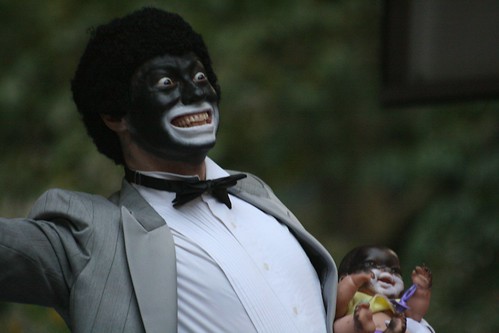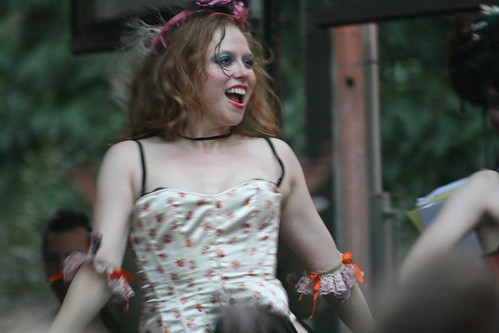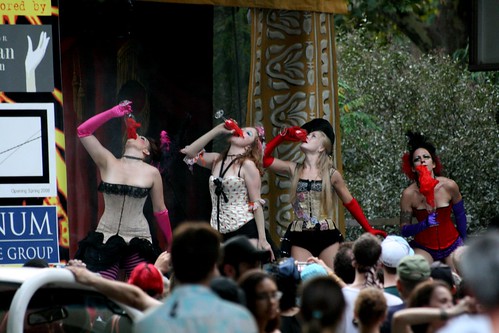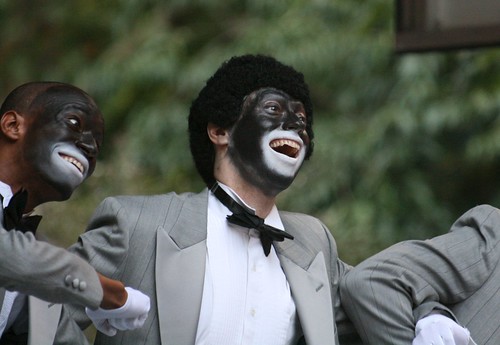What's wrong with this picture?

Michael T in blackface during the HOWL festival
As part of the HOWL festival in Tompkins Square Park, a small troop of performers sought to present a little bit of infamous Bowery history. In the face of the juggernaut of featureless modern high-rises which have been destroying the quaint and gentle architecture of the Bowery, they sought to remind us of the stories being torn down and plowed under. They concentrated on one building which survived assaults of social reformers in its day, and stood for years in an often marginalized and neglected part of town. When the wrecker's ball struck McGurk's, the ghosts of many of our most colorfully lost New Yorkers were made homeless.
This show intended to honor their memories, but one act at least, brought other more modern specters forward for some spectators.

Luc Sante describes in the book, "Low Life" how McGurk's Suicide Hall was one of the most notorious houses of prostitution in New York in the last decades of the nineteenth century. It received its name from the number of suicides by young girls who worked the place. Often their method of self murder was to drink carbolic acid. If done properly, it is a horrifically painful but certain death. Blonde Mage Davenport was one of the girls who successfully killed herself in this manner. She and her partner Big Mame, undertook to kill themselves together. Big Mame spilled most of the acid on her face, disfiguring her self and resulting in her being barred from McGurk's. McGurk's closed over 90 years ago.

The girls of McGurk's drink carbolic acid at the HOWL festival
Among the crowd who patronized McGurk's, and the other Bowery dives, one could find singers and comedians who roamed from saloon to saloon, playing music, dancing and singing for coins from the crowd. One such busker was Al Jolson. His act, in cork makeup, known as blackface, and familiar to most Americans from his acting in the early days of film with sound, was perfected on the Bowery in the last days of McGurk's.
Remembering the place of blackface in the Bowery's past, some present in the park during the festival were shocked to see Michael T, a White performer, lip sync to an Al Jolsen recording of "Mammy," flanked by two Black performers, also in blackface.

James Romberger, an artist and the husband of the festival's director describes the intent of the act as following: "The minstrel show was for years the only public persona of people of color. To reproduce an entertainment of that time without showing the racist aspects would have been a lie, like the racist America missing from such sanitized corporate entertainment as Martin Scorcese's 'Gangs of New York.'"
The intent of the performance was lost on some people. More, the reaction of the majority White middle class audience disturbed them, as did the MC's patter which praised Jolson in the present, breaking the illusion that this was a view of the past. As Scott Crary, the director of the film "Kill Your Idols" put it, referring to the performance and the audience reaction, "Al Jolson began his career on the Bowery. And I think they were beckoning a bit of post-modern awareness to mock that history. Still, the satisfied laughter and cheers from the crowd were uncomfortable to listen to. I can't admit to being entirely in on the joke."
Other's put it more simply. One reaction was described by Crary, " I saw Carl's friend, the black gentleman you photographed (under the title "evening light") in the crowd watching the girls that were on before Michael T. When the minstrels came out, he turned and pronounced it "bullshit" and walked away grumbling, clearly insulted." A similar reaction was that of James Bedford, a middle aged Black man, born in Georgia, who moved to New York after a time in Philadelphia. He has lived in New York since 1988 and is a building superintendent on Saint Marks Place. He had been talking to a friend in the crowd just before Michael T appeared on stage. I noticed he had left as soon as the performance began. I found him speaking to friends a few days afterwards and asked him about the performance.
"I didn't like it. They never miss a chance to make Black folks look bad. I looked at the crowd looking at it [Michael T's performance], they were laughing. I just walked off. There are just some racist-assed people. New York has gotten more racist than Georgia. Georgia has changed."
One of the friends he is speaking to is John Newsome, who moved to New York from Texas forty-two years ago. He speaks of his experience as a Black American and a Black New Yorker. In answer to a question, if a Gay activist in blackface is somehow expositive of some civil rights notion, some irony he replies that like all civil rights struggles, the Gay rights struggle has benefited from Black leadership on rights, and not returned the debt owed... "Blacks have been at the forefront of everybody else's' civil rights struggle and we're blamed for it, we don't benefit. The Gay struggle and the Black struggle are entirely different, unless you a Black and Gay. If I go into a place of business, I am a suspect, until they see my money and are sure I am going to spend it."
A White baby doll painted in blackface is presented, as Michael shouts, "Mah Baby! Mah baby!" A hooting laugh went up from the audience. For me, it was not a laugh at the racism of the times past ... it was a laugh with the racism of the times present. It was the release of the subconscious racism which accepts the different outcome of American promise in the segregation of our schools, the jailing of so many more of the targeted group by unspoken belief in difference of potential. For me, the idea of the baby in blackface was the infliction of racism on so much of White America at birth, and I could not join in the laughter.I just photographed the event. James Romberger responds, "As you say, you were unable to cheer for this part of the show; I consider that a valid response. Perhaps those cheering hailed the courage and skill of the notably multicultural performers rather than the image they projected; perhaps those not cheering were saddened and disgusted at facing America's racist past. Both responses are valid responses."
I remain unconvinced. While our schools in New York are still so separate and unequal, and Black New Yorkers remain permanent suspects, should we be laughing?


1 Comments:
I've gotten into quibbles with other people--mainly musicians--about use of racial epithets and "pickaninny" dialect in music. A surprising number of people seem to think that the general public should not be offended by it because it's "historical".
While I agree that I don't want to see the knowledge of this sort of thing die out, I'm afraid I'm more concerned that it not die out so we don't forget and risk it resurfacing as a novel form of entertainment in the future, or risk driving it underground and being resurrected later for shock appeal. I don't care if it's more "authentic" to sing "Rose of Alabama" in pseudo-dialect; I still can't see that it's worth offending that many people, or having people assume that I think and talk that way in real life, or teaching children that that image can be tossed around casually and for entertainment.
And yes, I'm quite aware that, while the stereotype in the Al Jolson/mammy form is somewhat dated, it's not actually historical. It just looks a little different these days. Furthermore, it's an unfair fight--there are no stereotypes of upper-class white people that can compare in offensiveness to blackface or to the fiction of the "happy hooker" (which is sure what this looks like, even if she's drinking carbolic acid).
Post a Comment
<< Home